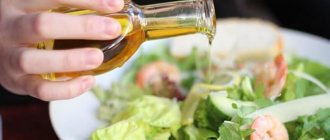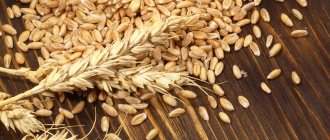The pear is an oblong-shaped fruit with a dense peel and firm, juicy pulp. The origin of the fruit is unknown, but today it is one of the most popular fruits in Russia after the apple. There are many varieties of pears of different sizes, colors, shapes and tastes. The pulp may be sweet or have a pronounced sour taste. The calorie content of pears also differs depending on the cooking method and variety. Thanks to its unique composition, rich in vitamins and minerals, the product has significant health benefits. It is necessary to take into account some contraindications for use.
Calorie content of pear
The calorie content and ratio of BZHU vary depending on the variety. Let's consider the composition and calorie content of the most popular ones.
| Variety | Kcal content per 100 g | Glycemic index | Proteins, fats, carbohydrates (BJU), g |
| Bartlett | 63 | 30 | 0,4*0,2*11,9 |
| Chinese | 42 | 24 | 0,5*0,2*10,7 |
| Conference | 42,9 | 24 | 0,4*0,3*10,3 |
Vitamin content:
- copper – 7.8 mcg;
- silicon – 6 mg;
- manganese – 0.037 mg;
- iron – 0.19 mg;
- phosphorus – 11 mg;
- magnesium – 6 mg;
- calcium – 9 mg;
- zinc – 0.08 mg;
- potassium – 101 mg;
- vitamin C – 4.4 mg;
- vitamin K – 3.8 mcg;
- vitamin PP – 0.164 mg;
- vitamin E – 0.12 mg;
- vitamin B6 – 0.026 mg;
- vitamin B5 – 0.042 mg;
- vitamin B4 - 5.1 mg;
- vitamin B1 – 0.012 mg;
- vitamin B2 – 0.026 mg.
How many calories in 100 g

When compiling a dietary diet, it is important to understand the calorie content of 100 g of product, as well as the average weight of fruits and vegetables.
In a whole fresh pear
Depending on the variety, a pear weighs from 100 to 180 g, the average weight of the fruit is about 130 g. Larger specimens are also found. The average calorie content of a fruit is 55 kcal.
In juice
Freshly squeezed pear juice contains about 45 kcal per 100 g, clarified - 46-50 kcal.
In processed fruit
When a fruit is processed, its calorie content and nutritional value changes. So, per 100 g of dried pears there are 201 kcal, baked fruit contains 179.8 kcal, dried - 249 kcal.
Canned pears contain on average 65 kcal. Per 100 g of pear jam there are 214.6 kcal, jam - 211.7 kcal, jam - 215 kcal. Pear marshmallow can contain 300-320 kcal.
Features of use
Pears should be eaten with the peel, since it contains the main amount of ascorbic acid and fiber. The maximum dosage for an adult is no more than 2 fruits per day. You should not eat pears and wash them down with water, especially cold water.
When losing weight
Those who want to lose weight, normalize metabolism and cleanse the intestines can regularly include pears in their diet. To do this, it is better to set aside a separate meal and eat pears with the skin, and, if possible, with the seeds. In the absence of contraindications, it is allowed to consume 1-2 fruits daily, choosing varieties with a small amount of sugar (they taste harder and sour).
For more effective and efficient weight loss, you can resort to fasting days on pears. In a week on such a diet, as reviews say, you can “throw off” up to 3-4 kg without feeling hungry and without exposing the body to acute vitamin and mineral deficiency.
There are many diets, but the following is the most popular. The essence of this nutrition system comes down to the fact that before lunch you can consume almost any dish (within the framework of proper nutrition, of course). In this case, nutritionists recommend taking a breakfast of slow carbohydrates (porridge) with a small amount of protein (cottage cheese, eggs).
You can “give” a snack to fiber and fatty acids (vegetable salad dressed with olive oil, nuts, seeds, a handful of dried fruits). At lunch you need to “lean on” carbohydrates (40% of the portion). The remaining part should be represented by proteins and fiber (a side dish of buckwheat, rice, durum spaghetti with boiled breast or steamed fish and a large portion of vegetable salad will do just fine).
After lunch, only raw pears are eaten. The first serving should be eaten no earlier than 2-3 hours after the meal. You can diversify the pear diet by replacing one of its methods with fresh pears, a salad of pears and low-fat yogurt, or baked fruits. It is important to monitor your water balance.
In addition to the indicated fresh juice, mineral water, herbal teas, and low-fat kefir are suitable drinks.
As you can see, this type of nutrition is not associated with a strong reduction in daily caloric intake. For more impressive results, you can use a two-week diet, during which you can get rid of 7-9 extra pounds. Breakfast here consists of a small piece of whole grain bread or a serving of oatmeal with water and pear. Lunch – buckwheat, wild rice with boiled breast. Dinner - vegetables and herbs. In between meals, eat 1-2 pears.
When going on a diet, it is important to remember that no matter how desired the result, extreme weight loss in a short time is stress for the body. And the kilograms lost so quickly usually return, “bringing” new ones with them.
For pancreatitis
The menu for pancreatitis depends on the characteristics and stage of the disease. A particularly strict diet must be followed during an exacerbation of the disease and in the first days of recovery after it. During an exacerbation of pancreatitis, consumption of pears is prohibited. On the 7th-8th day during the period of remission, some fruits and vegetables are allowed to be introduced into the patient’s diet.
Preference is given to non-sour apples. And although they contain more organic acids, they are better absorbed than pears. The latter contain stony cells in which chemical elements (cutin, calcium carbonate) can be concentrated that are not digested by the stomach of a sick person. Their presence can be guessed by the dense inclusions that are present in the pulp of pears.
For chronic pancreatitis, you are allowed to eat 1 fruit once a week. In this case, it is better to divide it into 3-4 parts and distribute it over several days. That is, the best option is a quarter of a fresh pear every 1-2 days. It is better, of course, to bake the fruits, since this will soften the stony cells mentioned above.
You can also prepare compotes and decoctions from pears. In this case, the notorious rocky compounds will settle at the bottom of the dish. You should not drink them, but before using it, it is advisable to filter the compote or decoction.
During pregnancy
During pregnancy, pears will provide a woman’s body with folic acid, strengthen the immune system and the cardiovascular system. In addition, they will help cope with constipation, which often occurs in the first and third trimester of the “interesting situation”.
During pregnancy, you are allowed to eat 1-2 fruits every other day. You should not eat them before breakfast or immediately after the main meal. A good option is to eat the fruit for an afternoon snack or as a second breakfast. But it is better to avoid eating these fruits at night because of their diuretic effect.
To learn how to prepare compote from whole pears for the winter, see the following video.
Pear is the second most popular fruit after apple. However, it is not inferior to it in terms of beneficial properties.
Useful properties of pear
- Pear compote is recommended to be consumed for prostate problems; naturally, this drink will not hurt for preventive purposes.
- Pear is indicated for diseases of the pancreas, obesity and diabetes
.
The thing is that, unlike most other fruits, pears contain more fructose rather than glucose
. And it is perfectly absorbed by the body without insulin. - Regular consumption of pears is the key to ideal hematopoiesis. Thanks to its high iron and folic acid content,
it will help counteract insufficient wound healing and also reduce excessive sensitivity to cold. - Positively affects the functioning of the heart and other muscles. All thanks to the high potassium content
. He will also save those who often suffer due to muscle cramps. - Pear improves metabolism and digestion
. The reason is the high content of organic acids. - For liver diseases, cholecystitis and gastritis, this fruit will help avoid discomfort in the intestines
. To do this, you need to eat two fruits every morning. - It is beneficial for the thyroid gland, helps absorb iron and remove excess water, and is also involved in the formation of hemoglobin
. All because of the daily requirement of cobalt, which is contained in only 100 grams of fruit.
Among the most common varieties are: Chinese, Conference, Williams and Pakham (South American and African variety).
Calorie content of pear
Calorie content of pears ranges from 42 to 48 kcal
.
The conference and Chinese have the lowest energy value
. They are firmer and less sweet than the tender and juicy Williams and Pakham. But the latter are great for making baby purees. The reason is not only their softness. These varieties are considered the least allergenic, so it is better to give them fresh to children.
The average weight of one pear is 200g. The average calorie content of 1 pear is 90 kcal.
How to Get the Most Benefits from Pears
- It is recommended to eat pears 30-60 minutes after eating.
- The fruit contains a lot of water, so after it you should not drink for an hour.
- Also, you should not eat pears before eating heavy food, especially meat.
- For discomfort in the stomach or exacerbations of chronic diseases of the digestive system.
Contraindications for eating pears
Pear is a sweet fruit that is a storehouse of vitamins and many other microelements. Ripe fruits are rich in fiber, carotene, fructose, iron and folic acid.
The first mentions of such a crop as pear were found in the chronicles of ancient China. Gradually it spread to many countries and was loved for its extraordinary taste and high decorative value.
Everyone loves it and eats it simply without any additions, uses it to make candied fruits, salads, pies, and also makes juice and jam. Sometimes the fruit is dried and very tasty compote and jelly are made.
Benefit
The juicy pulp of the fruit has a refreshing, invigorating effect, and also improves tone and improves mood.
The benefits of pear are very great - it is a source of a large amount of active substances necessary for the full functioning of all body systems. So, there are more than a dozen vitamins in its composition. Among them are A, the entire group of vitamins B, C, E, PP. The pulp also contains a lot of minerals. Among the microelements, it should be noted such as copper, selenium, iron, manganese, zinc, silicon and others. The chemical composition is also rich in macroelements sodium, calcium, potassium, and phosphorus. In addition, there are pectin compounds, organic acids, fiber, tannins and catechins.
Such a rich chemical composition causes a beneficial effect on the kidneys, liver, and stomach. At the same time, all components are absorbed as efficiently as possible, which leads to a significant improvement in well-being when consuming these fruits. It is worth noting that the pulp of this culture contains a lot of fructose, which is much more beneficial than its analogue glucose. Therefore, fruits and juice from them are recommended to be included in the diet for problems with the pancreas, and even for diabetes.
Contraindications
It must be remembered that, despite the enormous health benefits of pears, they can also be harmful if eaten while suffering from certain diseases, such as gastritis or ulcers. Also, you should not abuse the product if there are other inflammatory processes in the stomach and intestines. You should also not eat the fruit on an empty stomach, along with raw water, as this can cause you to feel unwell.
It is important to know the rules for its use: you should not eat it in the morning, drink it with water and eat fatty foods. Otherwise, stomach upset may occur. You should also refrain from eating unripe fruits during exacerbations of gastrointestinal diseases.
For those losing weight
Pear is an excellent dietary product, as it is low in calories and at the same time charges the body with energy and gives a feeling of satiety. Therefore, it is recommended to include fruit in the daily diet if a person adheres to a diet and loses weight in the absence of contraindications. However, you should not abuse it, like any other product.
The honeyed and aromatic pulp can be an excellent snack for those who maintain physical fitness.
The nutritional value
Many of us are interested in how many calories are in one pear and can it be consumed by those who carefully monitor their weight?
The healthy treat has low energy value. The average weight of one piece is approximately 136 g, while the calorie content of 1 pear is approximately 42 kcal.
Nutritional value per 100 g:
- Calorie content: 57 kcal
- Proteins: 0.4 g
- Fat: 0.3 g
- Carbohydrates: 10.9 g
Due to its low calorie content, pears are included in many diets.
Calorie content may vary slightly depending on the variety. Thus, Chinese varieties of pears are considered the lowest in calories, the energy value of which is only 42 kcal. Therefore, if you want to consume the most dietary product, you should give preference to them.
Kira Stoletova
The sweet and aromatic fruit is very popular all over the world. However, not every gourmet knows that their favorite fruits are classified as dietary products. What is the calorie content of a pear and what else does it contain? Let's look at the strengths and weaknesses in detail.
Is it possible to eat pears when losing weight on a diet?

Pear is a fat-burning fruit. Despite its pronounced sweetness, it does not contain many calories, and the high fiber content inhibits the absorption of carbohydrates and stimulates the work of the small intestine.
The high content of microelements and vitamins normalizes metabolism, improves the condition of hair and skin, restores the proper functioning of the digestive tract, and has a beneficial effect on the endocrine, circulatory and nervous systems. Folic acid in pear supports the immune system, stimulates the production of bile and leukocytes.
Important. For more complete absorption of nutrients, nutritionists recommend eating pears in the morning after breakfast. Evening consumption irritates the intestines and leads to congestion.
Benefits and harms
Like any product, pears have positive and negative aspects of consumption.
Some of the characteristic advantages include:
- low calorie content;
- high fiber content;
- normalization of metabolism;
- normalization of the gastrointestinal tract;
- increasing the functionality of the liver and kidneys;
- increasing the body's resistance to infections;
- reduction of inflammatory processes in the body;
- restoration of the hematopoietic system;
- strengthening vascular walls;
- normalization of blood sugar levels;
- reduction of swelling;
- reducing the risk of developing cancer;
- increased hemoglobin levels;
- restoration of the menstrual cycle in women and increase in potency in men;
- reducing the risk of developing premenstrual syndrome and combating its manifestations.
Despite the extensive list of advantages, there are also significant disadvantages:
- pronounced diuretic effect;
- allergic reactions;
- strong stimulation of digestion;
- dyspeptic symptoms – nausea, vomiting, diarrhea, bloating;
- can cause fermentation in the intestines when consumed with fatty meat, smoked meats and fermented milk products;
- Contraindicated for certain diseases of the gastrointestinal tract.
Results
Pear is a unique fruit rich in vitamins and minerals. When used correctly, it can improve the functioning of the immune system, strengthen the walls of blood vessels, regulate the functioning of the kidneys and liver, and alleviate the condition of urolithiasis. Due to its high potassium content, the fruit is beneficial for the cardiovascular system.
Pear is one of the few fruits that can be consumed on a diet, and for athletes this fruit will be an excellent natural energy booster.
Rate the material
Share:
How to choose and store correctly
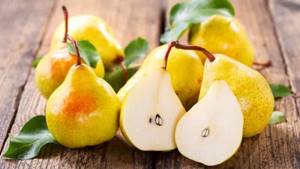
To get the maximum benefit from a fruit, it is important to select and store it correctly. In stores you can most often find unripe pears that need to lie down and ripen. They are kept for several days at room temperature - then they gain maximum benefit.
When choosing, be sure to pay attention to the following characteristics:
- there should be no black spots, dents or cracks on the skin;
- a good pear has a subtle pleasant aroma, too strong an aroma is a sign of spoilage of the fruit;
- the surface should not have a greasy coating or shine - a normal pear has a matte, somewhat waxy coating;
- the stalk is soft, elastic, does not break when you try to bend it, brittle and dry indicates an old fruit.
Pears are stored in the refrigerator in paper or plastic bags with pre-drilled holes. It is not advisable to store more than 0.5 kg of fruit in one bag. In this state, the fruit can be stored for up to a month. At room temperature, it can be stored for a short time in boxes with holes for better ventilation - up to two weeks.
For long-term storage, the fruit is placed on glazed balconies, having previously wrapped each one in paper or parchment. In this state, the fruits can be stored for up to three months.
Reference. Pears tolerate freezing well in any form, the main thing is to defrost them correctly.
general characteristics
The pear is a member of the Rosaceae family, which, in addition to flowers, includes a long list of delicious berries and fruits. Apples, cherries, plums, peaches, medlars, and raspberries also belong to this family. The fruits of the pear tree come in a variety of shades: green, red, yellow and even brown. Some of the varieties do not change their color after ripening, which makes it difficult to choose the fruit according to its degree of ripeness. Ripe fruits are sweet, tasty and rich in nutrients, while being as crisp as apples and juicy as peaches.
Content:
- general characteristics
- Pear varieties
- The nutritional value
- Benefit for health
- Fruit for beauty
- Other useful properties
- Use in the food industry
- Possible side effects
- How to choose and store correctly
Scientists have been debating the origin of this plant for several years now. Some believe that European (common) and Asian (Ussuri) pears developed as two different plants, but at about the same time (around 1000 BC). In addition to the named varieties, other species of this tree grew in different parts of Africa. But according to recent studies, China can be called the birthplace of pears.
Asian pears have a crunchy texture, are firmer and do not change after harvest, ideal for storage. European varieties are soft and juicy when ripe.
Today, pears are grown in almost all countries. But on a global scale, China is considered the largest producer of these fruits - it accounts for almost 3/4 of the total volume of pears. The fruit is also grown for industrial purposes in Argentina, the USA, some European countries, New Zealand, and South Korea. More than 3 thousand varieties are known, which differ in size, color, shape and taste of the fruit [1].
Consumption norms per day
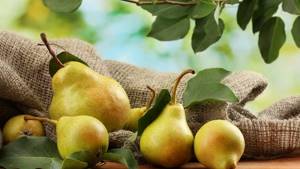
The norm for an adult is 1-2 fruits per day. More is allowed, however, when consuming such a number of pears, the volume of absorbed nutrients decreases in proportion to the quantity. Children can be given fruit slices from one and a half years old; from 8-10 months they can be given fruit in the form of puree.
Reference. For children under one year of age, pear is administered with great caution to avoid allergic phenomena. Starting from 1 tsp. purees per day, gradually increase consumption.
Chemical composition
The fruit contains a large amount of useful substances. The fruits contain enough iron, zinc and phosphorus. Lots of iodine, manganese, copper, and magnesium. Among the vitamins, group B stands out, in addition to retinol (A), ascorbic acid (C), P and PP.

Other useful elements include: tannins, folic acid, pectins, as well as fiber, carotene, sugars and other components. They are what make a person healthy, resilient and strong.
Contraindications

Like any product, pear has its contraindications for use:
- allergic reactions;
- exacerbation of gastrointestinal diseases;
- old age - with caution;
- peptic ulcer of the stomach and duodenum.
For diseases of the gastrointestinal tract, pears are allowed for consumption only with stable remission lasting more than one year.
Harm of fruit to the human body
Despite the extensive beneficial properties of pears, in some cases the fruit can be harmful. Let's take a closer look at some contraindications to eating the fruit.
So, pears should not be eaten
- during periods of exacerbation of gastrointestinal diseases;
- with the peel on an empty stomach (it is better to peel the peel, as it can absorb dangerous substances);
- never drink water after eating a pear, as this can cause heartburn;
- Avoid eating green fruits as they may cause constipation or indigestion.
Separately, it is worth mentioning the dangers of smoked products. Pears prepared in this way can be dangerous not only for people with ulcers or gastritis, but also for a completely healthy person. When smoked, carcinogens are formed in the product, increasing the risk of cancer.
When purchasing, pay attention to the peel of the fruit: if it is sticky, refuse to purchase such a fruit. Most likely, the pear peel is treated with diphenol, a substance that prevents rotting and preserves the fruit longer. This compound is dangerous to human health. If you have already purchased such a product, rinse it well in hot water and scrub it with a brush. It is even better not to eat this fruit with the peel.
As for the harm of pears after heat treatment, everything is ambiguous. On the one hand, this fruit helps with cough, but on the other hand, after baking, some of the beneficial substances are lost.
You should also be careful with dried pears, as they contain a lot of sugar. The product is not suitable for people who are on a diet. It is also undesirable to eat dried pear with dairy products, as this can lead to indigestion and flatulence.
But dried pears of the “Conference” and “Chinese” varieties, as well as compote from this fruit, are allowed to be consumed by everyone. However, you should make sure that you are not allergic to such products. And people with diabetes should refrain from eating dried pears, as they contain more sugar.
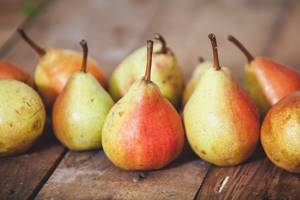
© glebchik – stock.adobe.com



